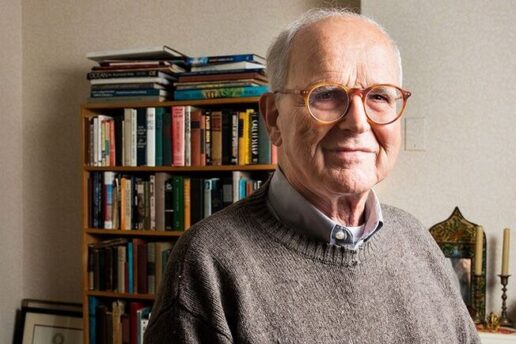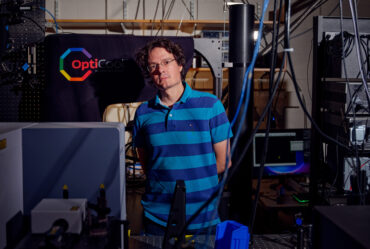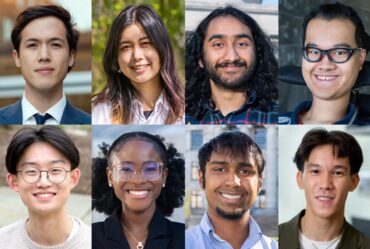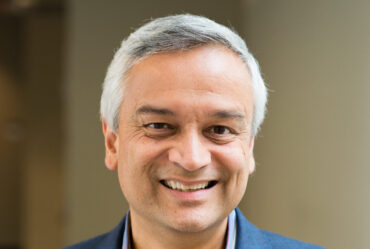
MIT physicist Rainer Weiss shares Nobel Prize in physics
LIGO inventor and professor emeritus of physics recognized “for decisive contributions to the LIGO detector and the observation of gravitational waves.”
Rainer Weiss ’55, PhD ’62, professor emeritus of physics at MIT, has won the Nobel Prize in physics for 2017. Weiss won half of the prize, with the other half of the award shared by Kip S. Thorne, professor emeritus of theoretical physics at Caltech, and Barry C. Barish, professor emeritus of physics at Caltech.
The Nobel Foundation, in its announcement this morning, cited the physicists “for decisive contributions to the LIGO detector and the observation of gravitational waves.”
“We are immensely proud of Rai Weiss, and we also offer admiring best wishes to his chief collaborators and the entire LIGO team,” says MIT President L. Rafael Reif. “The creativity and rigor of the LIGO experiment constitute a scientific triumph; we are profoundly inspired by the decades of ingenuity, optimism, and perseverance that made it possible. It is especially sweet that Rai Weiss not only served on the MIT faculty for 37 years, but is also an MIT graduate. Today’s announcement reminds us, on a grand scale, of the value and power of fundamental scientific research and why it deserves society’s collective support.”
At a press conference held today at MIT, Weiss credited his hundreds of colleagues who have helped to push forward the search for gravitational waves.
“The discovery has been the work of a large number of people, many of whom played crucial roles,” Weiss said. “I view receiving this [award] as sort of a symbol of the various other people who have worked on this.”
In describing what the award means to him in a larger context, Weiss said: “This prize and others that are given to scientists is an affirmation by our society of [the importance of] gaining information about the world around us from reasoned understanding of evidence.”
Listening for a wobble
On Sept. 14, 2015, at approximately 5:51 a.m. EDT, a gravitational wave — a ripple from a distant part of the universe — passed through the Earth, generating an almost imperceptible, fleeting wobble in the world that would have gone completely unnoticed save for two massive, identical instruments, designed to listen for such cosmic distortions.
The Laser Interferometer Gravitational-wave Observatory, or LIGO, consists of two L-shaped interferometers, each 4 kilometers in length, separated by 1,865 miles. On Sept. 14, 2015, scientists picked up a very faint wobble in the instruments and soon confirmed that the interferometers had been infinitesimally stretched — by just one-ten-thousandth the diameter of a proton — and that this minuscule distortion arose from a passing gravitational wave.
The LIGO Scientific Collaboration, with the Caltech-MIT LIGO Laboratory and more than 1,000 scientists at universities and observatories around the world, confirmed the signal as the first direct detection of a gravitational wave by an instrument on Earth. The scientists further decoded the signal to determine that the gravitational wave was the product of a violent collision between two massive black holes 1.3 billion years ago.
The momentous result confirmed the theory of general relativity proposed by Albert Einstein, who almost exactly 100 years earlier had predicted the existence of gravitational waves but assumed that they would be virtually impossible to detect from Earth. Since this first discovery, LIGO has detected three other gravitational wave signals, also generated by pairs of spiraling, colliding black holes; the most announced of a detection came just last week.
“We are incredibly proud of Rai and his colleagues for their vision and courage that led to this great achievement,” says Michael Sipser, the Donner Professor of Mathematics and dean of the School of Science at MIT. “It is a wonderful day for them, for MIT, for risk-taking and boldness, and for all of science.”
A gravitational blueprint
The detection was an especially long-awaited payoff for Weiss, who came up with the initial design for LIGO some 50 years ago. He has since been instrumental in shaping and championing the idea as it developed from a desktop prototype to LIGO’s final, observatory-scale form.
In 1967, Weiss, then an assistant professor of physics at MIT, was asked by his department to teach an introductory course in general relativity — a subject he knew little about. A few years earlier, the American physicist Joseph Weber had claimed to have made the first detection of gravitational waves, using resonant bars — long, aluminum cylinders that should ring at a certain frequency in response to a gravitational wave. When his students asked him to explain how these Weber bars worked, Weiss found that he couldn’t.
No one in the scientific community had been able to replicate Weber’s results. Weiss had a very different idea for how to do it, and assigned the problem to his students, instructing them to design the simplest experiment they could to detect a gravitational wave. Weiss himself came up with a design: Build an L-shaped interferometer and shine a light down the length of each arm, at the end of which hangs a free-floating mirror. The lasers should bounce off the mirrors and head back along each arm, arriving where they started at the exact same time. If a gravitational wave passes through, it should “stretch” or displace the mirrors ever so slightly, and thus change the lasers’ arrival times.
Weiss refined the idea over a summer in MIT’s historic Building 20, a wooden structure built during World War II to develop radar technology. The building, meant to be temporary and known to many as the “Plywood Palace,” lived on to germinate and support innovative, high-risk projects. During that time, Weiss came to the conclusion that his design could indeed detect gravitational waves, if built to large enough dimensions. His design would serve as the essential blueprint for LIGO.
An observatory takes shape
To test his idea, Weiss initially built a 1.5-meter prototype. But to truly detect a gravitational wave, the instrument would have to be several thousand times longer: The longer the interferometer’s arms, the more sensitive its optics are to minute displacements.
To realize this audacious design, Weiss teamed up in 1976 with noted physicist Kip Thorne, who, based in part on conversations with Weiss, soon started a gravitational wave experiment group at Caltech. The two formed a collaboration between MIT and Caltech, and in 1979, the late Scottish physicist Ronald Drever, then of Glasgow University, joined the effort at Caltech. The three scientists — who became the co-founders of LIGO — worked to refine the dimensions and scientific requirements for an instrument sensitive enough to detect a gravitational wave.
Barry Barish soon joined the team as first a principal investigator, then director of the project, and was instrumental in securing funding for the audacious project, and bringing the detectors to completion.
After years of fits and starts in research and funding, the project finally received significant and enthusiastic backing from the National Science Foundation, and in the mid-1990s, LIGO broke ground, erecting its first interferometer in Hanford, Washington, and its second in Livingston, Louisiana.
Prior to making their seminal detection two years ago, LIGO’s detectors required years of fine-tuning to improve their sensitivity. During this time, Weiss not only advised on scientific quandaries but also stepped in to root out problems in the detectors themselves. Weiss is among the few to have walked the length of the interferometers’ tunnels in the space between LIGO’s laser beam tube and its encasement. Inspecting the detectors in this way, Weiss would often discover minute cracks, tiny shards of glass, and even infestations of wasps, mice, and black widow spiders, which he would promptly deal with.
A cosmic path
Weiss was born in 1932 in tumultuous Berlin. When his mother, Gertrude Loesner, was pregnant with Weiss, his father, neurologist Frederick Weiss, was abducted by the Nazis for testifying against a Nazi doctor. He was eventually released with the help of Loesner’s family. The young family fled to Prague and then emigrated to New York City, where Weiss grew up on Manhattan’s Upper West Side, cultivating a love for classical music and electronics, and making a hobby of repairing radios.
After graduating high school, he went to MIT to study electrical engineering, in hopes of finding a way to quiet the hiss heard in shellac records. He later switched to physics, but then dropped out of school in his junior year, only to return shortly after, taking a job as a technician in Building 20. There, Weiss met physicist Jerrold Zacharias, who is credited with developing the first atomic clock. Zacharias encouraged and supported Weiss in finishing his undergraduate degree in 1955 and his PhD in 1962.
Weiss spent some time at Princeton University as a postdoc, where he developed experiments to test gravity, before returning to MIT as an assistant professor in 1964. In the midst of his work in gravitational wave detection, Weiss also investigated and became a leading researcher in cosmic microwave background radiation — thermal radiation, found in the microwave band of the radio spectrum, that is thought to be a diffuse afterglow from the Big Bang.
In 1976, Weiss was appointed to oversee a scientific working group for NASA’s Cosmic Background Explorer (COBE) satellite, which launched in 1989 and went on to precisely measure microwave radiation and its tiny, quantum fluctuations. Weiss was co-founder and chair of the science working group for the mission, whose measurements helped support the Big Bang theory of the universe. COBE’s findings earned two of its principal investigators the Nobel Prize in physics in 2006.
Weiss has received numerous awards and honors, including the Medaille de l’ADION, the 2006 Gruber Prize in Cosmology, and the 2007 Einstein Prize of the American Physical Society. He is a fellow of the American Association for the Advancement of Science, the American Academy of Arts and Sciences, and the American Physical Society, as well as a member of the National Academy of Sciences. In 2016, Weiss received a Special Breakthrough Prize in Fundamental Physics, the Gruber Prize in Cosmology, the Shaw Prize in Astronomy, and the Kavli Prize in Astrophysics, all shared with Drever and Thorne. Most recently, Weiss shared the Princess of Asturias Award for Technical and Scientific Research with Thorne, Barry Barish of Caltech, and the LIGO Scientific Collaboration.
Related links:


